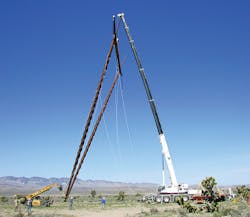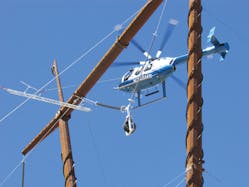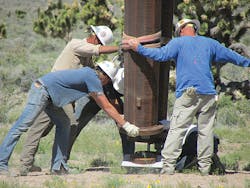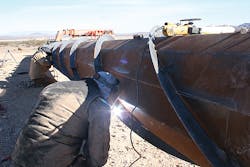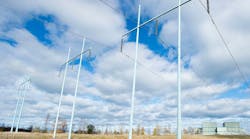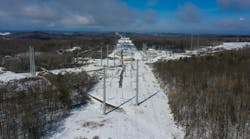Often the word “unique” is overused in today’s evolving society. However, that descriptor is completely appropriate to label the 231-mile (372-km)-long, single-circuit 500-kV One Nevada transmission line in the United States.
What other line caused construction workers to bundle up for an early fall mountain snowstorm at the exact time other workers on the same line had to stay hydrated because of temperatures that climbed to nearly 100°F (38°C)?
What other line is designed with a special tubular guyed-V structure to inhibit raptors from perching and attacking protected desert tortoises in southern Nevada or sage grouse in northern Nevada?
What other transmission line offers a critical solution to connecting two operating utilities for the first time and enabling Nevada customers to benefit from sharing generating resources?
And, what other line can simultaneously transport electrons from a large wind farm, numerous geothermal plants, large solar facilities and a small landfill energy resource?
The answer to these questions validates that the word “unique” does apply, indeed, to the One Nevada Transmission Line, or ON Line, which began serving homes and businesses in Nevada on New Year’s Day 2014.
Renewable Energy
The diversity of renewable energy in Nevada towers above most states, and ON Line plays a key role in enabling the energy to flow to customer load centers. Prior to the completion of this line, the energy from 20 separate geothermal projects could only be used in northern Nevada. Energy from eight of those geothermal projects is specifically contracted — through ON Line — to NV Energy’s operating company that serves the greater Las Vegas, Nevada, area. Energy from the rich solar resources in southern and central Nevada now can flow both directions on the line and find its way to where it is needed most.
One groundbreaking project that will use the new transmission line almost exclusively is the 110-MW Crescent Dunes Solar Energy Project, which is the largest solar power tower project with energy storage. Thanks to a molten salt storage system, this project can provide solar energy long after the sun has gone down and when air conditioners are still running full blast to counter midnight temperatures well above 90°F (35°C).
The new transmission line also is being used to move up to 152 MW of wind power from the Spring Valley Wind Project in eastern Nevada to Las Vegas, as well as a small landfill gas-to-energy project in northern Nevada. Overall, the initial phase of the line is designed to carry nearly 600 MW of renewable energy.
A Collaborative Effort
NV Energy teamed up with Great Basin Transmission-South, LLC, an affiliate of LS Power, to develop and build ON Line. Great Basin owns 75% of the line and NV Energy owns 25%, although NV Energy has rights to 100% of the line’s initial capacity.
NV Energy managed the construction process, which included 844 towers, a new 500/345-kV substation located in a remote part of Nevada, a 20-tower backup microwave communications network, a short tie-in line with the utility’s existing 345-kV transmission system in northern Nevada, and upgrades to the 500-kV Harry Allen substation north of Las Vegas.
Sturgeon Electric Co. Inc., a MYR Group Inc. subsidiary, provided construction services for ON Line, including environmental protection measures, right-of-way clearing, foundation installation, structure installation, and installation of the conductor and shield wires.
Wilson Utility Construction Co. provided construction services for the new Robinson Summit substation west of Ely, Nevada. Its involvement included environmental protection measures, grading, foundation installation, structure installation and installation of electrical equipment.
POWER Engineers provided the engineering services for the transmission line and substation.
Unique Tower Design
The ON Line project is considered the first in the industry to use a reverse-tapered, tubular guyed-V structure configuration. The structures range in total height from about
110 ft to 160 ft (34 m to 49 m), depending on local terrain, span issues and elevation changes. The structures are made from self-weathering steel, which evolves to a rich brown color that blends well in the desert environment of Nevada.
The new line runs almost exclusively through federal land managed by the U.S. Bureau of Land Management, and the structures offer one of the smallest tower footprints of any structures previously used.
The guyed-V structures use a reverse-tapered, thin-walled tubular steel leg, which minimizes the tower weight and footprint. It rests on a tapered concrete pedestal foundation that measures about 6 sq ft (0.5 sq m), with a reveal of only about 1 ft (0.3 m), and measures roughly 3 ft by 1.5 ft (0.9 m by 0.5 m). The legs rest on two steel rocker plates and pins that fit into the bottom of the tower legs.
The only other footprint elements are the four corner grouted soil and rock anchors, which were drilled to depths up to 40 ft (12 m). Each anchor was field-tested to 80,000 lb (36,287 kg) and is the termination for two guy wires, one of which has a 0.875-inch (22-mm) diameter and the other has a 0.5-inch (13-mm) diameter. More than 3,000 anchors were installed and only two failed the pull test and needed replacing.
Hoisting into Place
The tubular guyed-V tower structures all were assembled on site and installed with the use of a single crane, forklift and individual work trucks at the four anchor points. Over time, the carefully choreographed and practiced crews of about 10 workers were able to install a new V-tower every 50 minutes. That process included time for the large crane to lumber to the next tower site, set up, extend, lift the structure, set it on the foundation and hold in place while the tower was plumbed and the main guy wires were tensioned to about 10,000 lb (4,536 kg).
Lead lines for the ON Line conductor, overhead and optical ground wires all were flown in by helicopter, which dramatically shortened the construction time associated with traditional pole climbing or high-lift bucket support. Helicopters were also used to inspect the completed towers and work, as well as to help install backup microwave towers on remote mountain peaks in Nevada.
Environmental Attention
All of the work crews received environmental awareness training to learn and understand the sensitive environmental resource issues associated with the project’s activities. For example, protected desert tortoises presented the most sensitive issue for the project. Biological monitors surveyed work areas prior to construction activity, safely relocated tortoises from harm’s way when necessary and supported all work crews during their work to ensure compliance with environmental requirements. Biological monitors also escorted dust-mitigating water trucks, work crews and equipment moves throughout the desert tortoise habitat as well as the habitats of other sensitive species of plants and animals.
Additional specialized personnel surveyed and monitored construction activities for the protection of sensitive plants, paleontological resources, archaeological resources, migratory birds and greater sage grouse.
Certain protected plant species — such as cactus and yucca plants — in planned construction areas or on new access roads were temporarily moved from harm’s way and maintained during the construction phase of the project. After the construction work, the areas were recontoured and decompacted. Any topsoil removed prior to construction was replaced to help maintain the native seed bank.
To further support successful revegetation of the temporary work areas, seeding was done using native plant seed mixes corresponding to the local vegetation community, and the cactus and yucca plants that had been removed prior to construction were replanted. Crews took care to ensure each plant was replanted as close to its original location and orientation as possible.
Certain restrictions also were imposed on construction activities in specific areas because of sensitive seasonal wildlife activities, such as mule deer wintering grounds, sage grouse lekking and migratory bird nesting. In accordance with the Edison Electric Institute’s Suggested Practices for Avian Protection on Power Lines and in coordination with the Bureau of Land Management, Nevada Department of Wildlife, and U.S. Fish and Wildlife Service, project structures were designed to avoid electrocution of eagles and other large raptors. Specific structures were fitted with perch-deterring devices to discourage ravens and raptors from perching and nesting on structures within sensitive habitats for sage grouse and desert tortoise.
Thanks to the sharp eye of an environmental monitor, evidence of a 300-million-year-old plant was found near the ON Line construction activities. The rare-for-Nevada fossil clearly shows the diamond-shaped bark pattern of a lepidodendron tree, which grew to more than 100 ft (31 m) tall.
Wind-Induced Vibration Issue
One of the lessons learned about the new tubular guyed-V structures is that the tall slender structure was susceptible to wind-induced vibrations. The solution involved retrofitting the towers with helical strakes from Chicago Metal Rolled Products. Helical strakes are cost-effective and well-tested devices that alter the flow of wind around the tubular structures and disrupt vortex shedding.
Thanks to extensive testing and ongoing vibration monitors at 11 towers, the helical strake solution successfully mitigated the wind-vibration problem.
Good To Be Connected
NV Energy has evolved from two separate operating companies in Nevada — Sierra Pacific Power Co., which serves about 42,000 sq miles (108,780 sq km) in the northern and western part of the state, and Nevada Power, which serves the greater Las Vegas area. With ON Line achieving commercial operation on Jan. 1, 2014, the two operating companies are now directly connected and can share generating resources from 10 separate power plants and 38 renewable energy projects in Nevada.
This energy independence will help the utility to provide even greater reliability and customers can avoid paying the high costs of purchased electricity outside of its control area during the hot summer months when electricity on the market is at a premium.
Safe and Sound
At the height of construction, more than 400 workers contributed to the project. Not counting the thousands of hours for planning, management, engineering and other support services, more than 725,000 work hours were spent on specific construction and environmental services. Safety was a key priority emphasized before a single shovel of dirt was turned and stressed each day on the job. Remarkably, the total lost-time incident rate came in at a low 1.10, but even one accident that resulted in injuries was too many.
Not only was the project safe, but its leadership successfully guided the construction process through several challenges associated with working around sensitive species, in extreme hot and cold environments, in high-wind conditions and through necessary technical changes.
John Berdrow ([email protected]) served as project manager for the One Nevada Transmission Line. He has been with NV Energy for 30 years and has extensive project management, engineering, environmental permitting, construction and related experience in the electrical industry. He received his BSCE degree from the University of Nevada, Reno, and is a registered professional engineer in Nevada and California.
Steve Payne ([email protected]) was project engineer for the One Nevada Transmission line. He has been with NV Energy for 13 years and has served as the principle engineer on numerous major transmission system projects in the West. Previously, he was with Arizona Public Service and PacifiCorp. He has a BS degree from Brigham Young University and is a registered professional engineer in Nevada.
Companies mentioned:
Chicago Metal Rolled Products | www.cmrp.com
Edison Electric Institute | www.eei.org
HDR | www.hdrinc.com
LS Power | www.lspower.com
NV Energy | www.nvenergy.com
POWER Engineers | www.powereng.com
Sturgeon Electric Co./MYR Group | www.myrgroup.com
Wilson Utility Construction | www.wilsonconst.com
ON Line Project by the Numbers• 844 total towers, 759 with the new tubular guyed-V design• 11 million ft (3.4 million m) of conductor• 25 million lb (11.3 million kg) of steel for the towers• 3,036 new anchors• 13 new microwave towers; 20 total in communications network• 1.4 million total work hours• 101 million gal (382 million l) of water used for dust control


